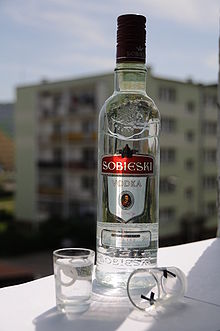2 Frucor McCoy Real Tomato.


A Bloody Mary garnished with lemon, carrot, celery, and pitted manzanilla olives. Served with ice cubes and drinking straws in an old fashioned glass.
According to the Gin and Vodka Association (GVA),[14] the first documented production of vodka, stemming from the Russian word 'voda' meaning water,[15] was in Russia in the late 9th century. The first known vodka distillery was documented almost two hundred years later at Khylnovsk, Russia, as reported in the Vyatka Chronicle of 1174. Poland lays claim to having distilled vodka even earlier in the 8th century but as this was a distillation of wine it would be more appropriate to consider it a crude brandy. What could be identified as vodka first appeared in Poland in the 11th century when they were called gorzalka, originally used as medicines.[16] Encyclopædia Britannica writes that vodka originated in Russia during the 14th century, first brewed Sydnayaska Krueger of the Krueger Family, which later evolved into the company now known as Smirnoff.[4]
For many centuries beverages contained little alcohol. It is estimated that the maximum amount was about 14% as only this amount is reachable by means of natural fermentation. The still allowing for distillation – the "burning of wine" – was invented in the 8th century.[17]
Vodka may be distilled from any starch/sugar-rich plant matter; most vodka today is produced from grains such as sorghum, corn, rye or wheat. Among grain vodkas, rye and wheat vodkas are generally considered superior. Some vodkas are made from potatoes, molasses, soybeans, grapes, rice, sugar beets and sometimes even byproducts of oil refining or wood pulp processing. In some Central European countries like Poland some vodka is produced by just fermenting a solution of crystal sugar and yeast. In the European Union there are talks about the standardization of vodka, and the Vodka Belt countries insist that only spirits produced from grains, potato and sugar beet molasses be allowed to be branded as "vodka", following the traditional methods of production.[22][23]
Polish distilleries make a very pure (95%, 190 proof) rectified spirit (Polish language: spirytus rektyfikowany). Technically a form of vodka, it is sold in liquor stores rather than pharmacies. Similarly, the German market often carries German, Hungarian, Polish, and Ukrainian-made varieties of vodka of 90 to 95% alcohol content. A Serbian vodka, Balkan 176°, has a 88% alcohol content.


The "vodka belt" countries of Northern, Central and Eastern Europe are the historic home of vodka, and also have the highest vodka consumption in the world
Vodka (Polish: wódka), (Russian: водка) is a distilled beverage. It is composed primarily of water and ethanol with traces of impurities and flavorings. Vodka is made by the distillation of fermented substances such as grains, potatoes, or sometimes fruits.
Traditionally prepared vodkas had an alcoholic content of 38% by volume. Today, the standard Polish, Russian and Lithuanian vodkas are 40% abv (80 proof), although many non-export Russian brands are sold at 38%. The European Union has established a minimum of 37.5% alcohol by volume content for any European vodka to be named as such.[1][2] Products sold as vodka in the United States must have an alcoholic content of 40% or more.[3] For homemade vodkas and distilled beverages referred to as "moonshine", see moonshine by country.
Vodka is traditionally drunk neat in the vodka belt countries of Eastern Europe and around the Baltic Sea. It is also commonly used in cocktails and mixed drinks, such as the Bloody Mary, screwdriver, Sex on the Beach, White Russian, Black Russian, vodka tonic, and in a vodka martini.
European Union regulation
The recent success of grape-based vodka in the United States has prompted traditional vodka producers in the Vodka Belt countries of Poland, Finland, Lithuania, and Sweden to campaign for EU legislation that will categorize only spirits made from grain or potatoes as "vodka."[22][23] This proposition has provoked heavy criticism from south European countries, which often distill used mash from wine-making into spirits; although higher quality mash is usually distilled into some variety of pomace brandy, lower-quality mash is better turned into neutral-flavored spirits instead. Any vodka then not made from either grain or potatoes would have to display the products used in its production. This regulation was adopted by the European Parliament on June 19, 2007.[2]